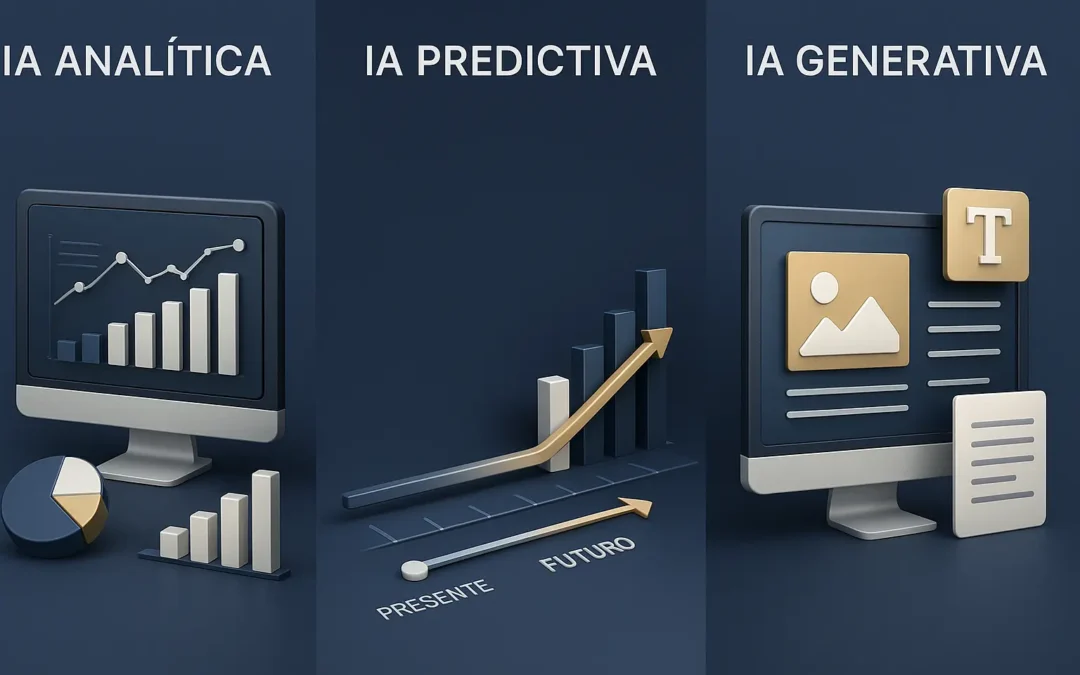“Artificial Intelligence” has evolved from a buzzword into a fundamental business capability. For forward-thinking organizations, the question is no longer if they should adopt AI, but how to effectively integrate it into their operational canvas to drive growth, efficiency, and a sustainable competitive advantage. This isn’t about isolated projects, but about weaving intelligence into the core of decision-making.
This isn’t a single magic bullet, but a set of powerful tools. Think of them as three distinct brushes, each with a specific function, that you can use to paint a sharper, more predictive, and more creative picture of your business’s future.
Analytical AI: The Brush that Reveals Reality in Depth
- What it paints for me: Analytical AI goes beyond traditional reports. It examines your historical data to reveal not just what happened, but why. It is your high-definition rear-view mirror, transforming vast volumes of sales, marketing, and operational data into a clear, actionable landscape. It answers the question, “Where have we been, what hidden patterns exist, and what strategic lessons can we learn?” Its value lies in turning raw data into a business diagnosis.
- Example (Retail): A retail company uses Analytical AI to cross-reference sales data with inventory levels, in-store foot traffic, and marketing campaigns. The system not only identifies that stores in the northern region had a 40% lower conversion rate in a product category, but it also reveals the problem was concentrated on weekends and correlated with stockouts of the most promoted items. With this precise diagnosis, management can adjust last-mile logistics specifically for that region and optimize staffing for peak demand.
- Example (Finance): A financial institution uses Analytical AI to segment its customers with previously unthinkable granularity. Instead of grouping by income, it analyses transaction patterns, digital channel usage, and investment types to identify “micro-segments” like “young professionals saving for a home.” This allows the company to design products and communications that resonate directly with the real needs of each group.
Predictive AI: The Brush that Sketches Tomorrow with Precision
- What it paints for me: Predictive AI uses your historical data and machine learning algorithms to forecast future outcomes with a high degree of probability. It allows you to shift from reactive management to a proactive strategy. It is your data-driven crystal ball, enabling you to anticipate demand, predict customer churn, optimize pricing, and mitigate risks before they impact your bottom line. It answers the question, “Where are we heading, and how can we prepare?”
- Example (Logistics): A logistics and distribution company takes optimization to the next level. Its Predictive AI system not only analyses routes and weather but also integrates macroeconomic data, port congestion indicators, and its top clients’ purchasing patterns. The system predicts a demand spike for electronic components three weeks in advance. The company can then negotiate freight capacity ahead of time, re-route inventory to key distribution centers, and offer clients guaranteed delivery windows, gaining market share through reliability.
- Example (Human Resources): An organization’s HR department uses a predictive model to identify employees at high risk of leaving. The model analyses factors like commute time, lack of salary progression, performance reviews, and participation in training programs. Instead of waiting for resignations, HR can proactively intervene with personalized development plans, mentorship opportunities, or compensation adjustments, reducing key talent turnover.
Generative AI: The Brush that Creates New Possibilities at Scale
- What it paints for me: Generative AI, the technology capturing everyone’s imagination, acts as a co-pilot for innovation and productivity. It creates entirely new and original content and solutions. From drafting thousands of personalized product descriptions to generating software code and simulating new engineering designs. It answers the question, “What can we build, automate, or communicate at an unprecedented scale and speed?”
- Example (Marketing): A marketing team operating at scale needs to personalize its campaigns. Using Generative AI, they can automatically create thousands of email variations. The system not only tailors the text but also generates unique product images that align with each customer’s browsing history (e.g., showing a car in the same color, the user configured online). This enables a hyper-personalization that feels individual and relevant, dramatically increasing engagement and conversion.
- Example (R&D): A pharmaceutical company uses Generative AI to accelerate drug discovery. The models can generate and simulate novel molecular structures that could be candidates for treating a specific disease, drastically reducing the time and cost of the initial research phases compared to traditional trial-and-error methods.
How to Start Painting?
These three types of AI are not mutually exclusive; their true power is unlocked when combined. Analytical AI uncovers a problem, Predictive AI forecasts its future impact, and Generative AI creates the personalized communication campaign to solve it.
Think about your most pressing challenge. Do you need a deeper diagnosis (Analytical), better forecasting (Predictive), or the ability to innovate faster (Generative)?
Which of these three types of AI could have the biggest impact on your business?
If you want to explore how these tools can be applied to your strategic canvas, send me a direct message.

